French meals – Customs and gastronomic guides – Eating the French way
This post is also available in:
![]()
French meals and restaurants: when you visit Paris or France, it will be an important topic. You will be confronted with the habits and customs of its inhabitants. And of course, the importance of the table being what it is for a French person, it will be to these “eating” habits that you will be regularly reminded. You might as well know them and possibly apply them during your stay.
Note
To better understand the way of life of the French, click on Preparing your trip to Paris directly and easily from home.
Rhythm and habits of French-style meals
Usually, the French punctuate their days with meals at fairly precise times:
- Breakfast in the morning.
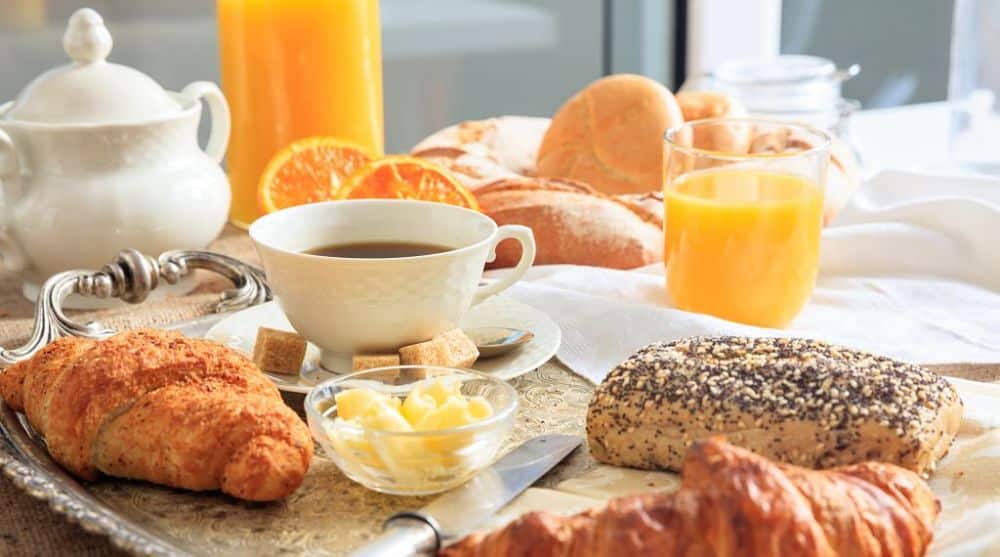
It often consists of buttered slices of bread with or without jam, accompanied by coffee (lighter than espresso) or tea in a large cup or a hot chocolate. A croissant may be added (for the holidays). This is what you find most of the time in hotels under the name of “continental breakfast”.
- Lunch is usually served between 12 and 1 pm.
It can be the main meal or a light meal (1 or 2 courses), especially for those at work. If it is the main meal it will be with 3 or 4 courses. - Dinner is taken between 7:00 pm and 9:00 pm
It can therefore be the main meal (for those whose lunch was frugal) or a light meal for others.
Other rules linked to French meals and restaurants:
- The French always eat bread with a meal, and the breadbasket is an essential element on any table.
- If there is a cheese course and a dessert, the cheese course always comes first. At least three different cheeses will usually be served, except in a lot of price meals. Cheese is eaten with bread, not with biscuits.
- Don’t confuse salt and pepper pots. In France, the salt pot has several holes, and the pepper pot just one. Alternatively, there may be coarse sea salt, considered of finer quality than ordinary salt, and pepper from a pepper mill (in good level restaurants).
Consistency of French meals
The main points to remember concerning French meals
- a starter (une entrée), such as a mixed salad, soup, some terrine, or paté.
- a main course, (le plat principal), typically a choice of meat or fish, with potatoes, rice, pasta, and/or vegetables.
- a cheese course as an option (often a selection of local cheeses). The waiter will show on the cheese plate the différent kinds.
- desserts are usually not detailed on the menu, so you have to listen to the waiter. Common choices include fruit tart (such as apple tart, tarte aux pommes), crème caramel, ice cream (glaces). Coffee at the end of the meal is an optional extra.
Many restaurants offer a special fixed lunchtime menu, with limited choice, called le Menu du jour.
Note
French meals in restaurants have a reduced share of fresh vegetables, cooked or not, and fresh fruit. You will notice that the quantity of vegetables with the main course is not very important, fruits are not often proposed. This is not very hygienic for your health and especially your intestinal transit. Don’t forget the “mixed salads” and complete salads very often proposed on the menus.
If you walk the streets as a tourist, you can easily buy fruit in the local fruit and vegetable stores that you will come across. You buy what you need, they are not expensive, they are sold “by the piece” or in very small quantities and you can eat them on a nearby bench.
The light French meals
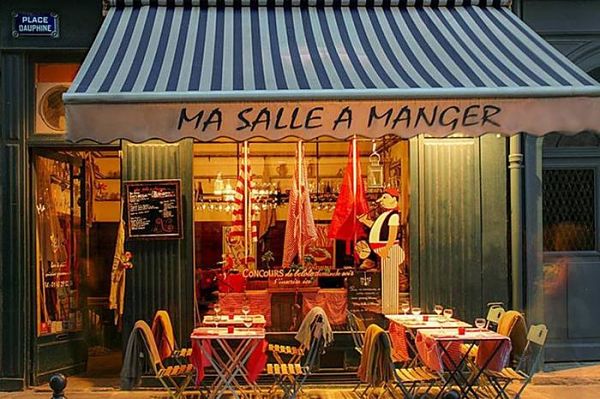
It very often consists of 2 courses, regardless of the “heaviness” of the food that makes it up. This is what is proposed in restaurants, especially at midday, for people at work: 1 starter + the main course or your choice of main course + a dessert. It is then a “part” of the complete menu in “3 courses”. The cheapest meal is often called “le Menu du jour” (the menu of the day): it includes usually the 3 traditional “basic” dishes to choose from. Sometimes the wine “du patron” (restaurant owner’s wine) is included, as well as coffee (espresso) after dessert. The taste quality is not always of the best, but there can be good surprises.
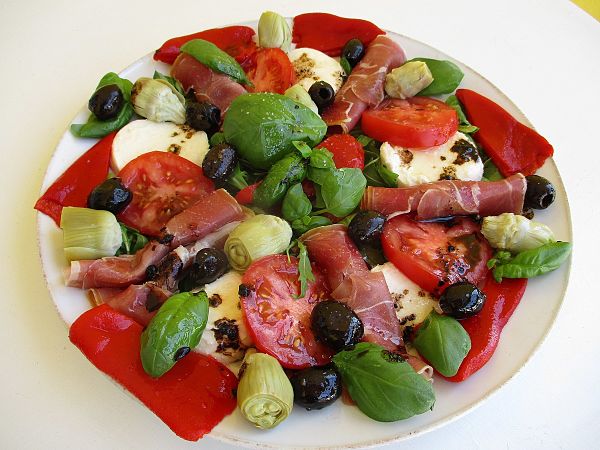
Often it is also possible to order “a salad with dressing” which includes in a large plate green salad, tuna or eggs, ham, or other proteins that you have to choose. Of course also the French sandwiches, of uneven quality depending on the bread used and the “filling” ingredients. Do not forget the croque-monsieur (slice of ham on a slice of bread, with cheese like fondue, all baked in the oven) or croque-madame, the ham being replaced by chicken. It is delicious too.
The price of a French meal starter + main course is about 18 to 25 €, a “garnished” salad about 20 €, a “3-course” meal less than 30 €. The aperitif, wine, and coffee are often extra.
Do not forget that the drink is not included and that it is with the aperitif and the wine that the note swells. But nothing prevents you from not having an aperitif or from asking for sparkling water or not (which is often expensive, around 3 € for 50 centiliters which is 1/2 liter). Supreme saving: order “a carafe of water”: you will get tap water for free. Tap water in France is strictly controlled to be germ-free.
The main French meals for a French
See below a sample menu to give you an idea and make your mouth water… Note that menus are also available in English and also European languages – with some exception in cafés.

French meals consists of a starter, a main course, a cheese, and a dessert.
This is what you find in restaurants under the name of “Menu” except that very often it consists of only 3 courses normally sufficient copious, the cheese being an “extra”.
The “menu” also allows you to have 3 or 4 choices per dish for a lower price than the “à la carte” order. A la carte, you will find in return more “top-of-the-range” choices, with more sophisticated “ingredients”.
For this main meal, many take wine (extra) to accompany the meal. See the wine list “at the time of ordering” so as not to be surprised by their price. Note that a bottle of wine contains 75 cl (or 3/4 of a liter), which makes about 5 glasses of 15 cl (which is usually the norm). Half bottles are also sometimes available (37,5 cl).
Don’t forget that you can order wine “by the glass”. It is practically not more expensive than a bottle. This brings another advantage: you can for example start with a glass of white wine, very often perfect for a starter, and order a glass of red wine more suited to the main course. Count 2 to 5 € per glass, depending on the quality of the wine.
Note
If you have rented a car, the driver must not have a blood alcohol level higher than 0.5 grams (g) per liter of blood. If it is checked above, it will be a fine, plus a withdrawal of points on the French driving license, possibly a prohibition to leave with the car, unless a sober passenger can drive and replace him.
As a consequence, not everyone is equal: a strong person will have more blood so he can drink a little more with impunity. In practice, one should not exceed 2 glasses of wine (at 13° alcohol) for a man and 1 1/2 glasses for a woman. The alcohol level decreases very slowly in the blood. It takes several hours.
Of course, there are exceptions: in their “everyday” life, some people “skip” a meal, or don’t have breakfast, or take 2 main meals a day. For various reasons, often for fear of gaining weight. But there are also gourmet meals for those who like to enjoy a good meal.
Gastronomic french meals and restaurants
In good neighborhood restaurants, you can find gastronomic meals that are worth eating. But of course, gastronomic meals are mainly found in high-end restaurants, Michelin starred or not.
A gastronomic meal is distinguished first and foremost by the choice of food offered, then the way it is prepared, and finally the way it is served. The setting of the restaurant is also taken into account in those that are recognized by reference labels (ex: Forks and stars of the Michelin Guide) –> See below the labels
A gastronomic meal usually consists of 4 courses (starter, main course, cheese, and dessert), sometimes 5 because it becomes then a “tasting menu”. But be reassured: the cuisine is light and most often the portions are small but very well presented. You don’t end the meal with a feeling of heaviness or hunger in your stomach.
Finally, the price: it can vary enormously, depending on what we can call a “gastronomic meal”, the setting and the reputation of the Chef. Do not expect less than 50 € per person, wine, aperitif, and coffee in addition. And this price can go up to several hundred euros per guest in Michelin-starred restaurants.
Note
Snails: in fact, only the body of the snail is eaten, it has almost no taste. The taste comes from the seasoning made of pure butter mixed with parsley, garlic, etc. The snails are served by 6 or 12.
Frogs legs: a dish consisting of 9 to 12 legs. They are cooked in butter in a frying pan at high temperature, with the seasoning (garlic, parsley, etc.) that gives the taste. “Fatty” dish, not recommended for fragile stomachs.
Restaurants and tourist guides
There are gastronomic guides that give the opinion of their authors only in gastronomic matters and other tourist guides that present sites to visit and in addition to good addresses where to eat.
Gastronomic guides
- The Michelin Guide, known as the “Red Guide” because of its cover.
It is the most emblematic and most popular gastronomic guide. Created in 1900, the famous red book is an essential reference for anyone looking for a high-flying table.
The authors of the guide use 5 very precise criteria to evaluate a restaurant: the quality of the products, the mastery of cooking and flavors, the personality of the cuisine, the quality/price ratio, and the regularity between visits (indeed, critics visit the same restaurant several times before deciding whether or not it should be included in the guide). The interviewers then agree to award 1 star (very good restaurant), 2 stars (very good cuisine), or 3 stars (exceptional cuisine).
The Guide Michelin group also publishes the Bib Gourmand every year, a guide to good restaurants where the price of the menu does not exceed 32 euros in the provinces and 36 euros in Paris. Very interesting to consult.
- The Gault et Millau is one of the most influential, along with the Michelin guide.
Contrary to the Michelin Guide, which awards stars, the Gault Millau investigators give a mark to each establishment, which receives a toque from 13/20 and up to 4 toques for a 20/20. Each year, the “Chef of the Year” is designated.
- The Fooding Guide. This Fooding guide shakes up these two reference guides with a single desire: “to discover a certain idea of the unique good taste and to open a more libertarian path in the world of gastronomy”. The guide, created by Alexandre Cammas in 2000, lists hundreds of good addresses throughout France for gourmets looking for a quality address with a real identity and a “love of the beautiful ordinary”.
- The Pudlo Guide by the renowned Gilles Pudlowski.Journalist, columnist, critic but also writer, the former collaborator of the Gault&Millau travels throughout France in search of restaurants with a “soul”.
Gilles Pudlowsky is also very active on social networks, notably on Instagram, to guide you in your research. The journalist also refers to the one who is, according to him, the “Cook of the Year”.
- Guide Lebey for Paris and surroundings
If you live in Paris or its surroundings, you will be inspired by your choice of restaurants, the best addresses of restaurants, but also bistros and cocktail bars in Paris and its region from the Guide Lebey.
The critic and his team travel around the capital to find the best addresses according to several criteria: the quality of the cuisine, the bread, the wine list, or even the coffee. You will notice some symbols used by the guide: baguettes (1 to 3) for the quality of the bread or small cups of coffee (1 to 3 also) for the coffee, etc. The reader knows what to expect for each “compartment” of the meal.
Tourist guides
Finally, some tourist guides make their own recommendations of restaurants (and even hotels). These two books, in particular, very well known in France and often abroad, inform tourists about cultural visits and good hotels and also act as gastronomic guides.
- Le Guide du routard (“The backpacker Guide” – tourist guide including restaurant tips) published by Hachette
- Le Petit Futé (“Little Clever” – tourist guide) https://www.petitfute.com/
Other types of restaurants in France
There is a multitude of various other restaurants, mostly not “French-inspired”. Some are good, many a little less good, at least for French palates. However they have their clientele, often they are cheap, so why not try them?
Self-service restaurants in France: Les “self”
Self-service restaurants are known in France as cafeterias or as just “selfs”. They can be found in motorway service areas, some big gas stations, city centers, and in most large superstores on the outskirts of town. They provide food of reasonable quality, but for logistical and price reasons use more processed food than independent restaurants do.
“Diners” restaurants.
American-style diners are not part of the traditional French dining out environment, but they do exist.
The most popular chain, with outlets in car-friendly suburban locations (near shopping centers or hotel zones), is the distinctly American-themed “Buffalo Grill”. The waiters will even ask you what kind of dressing you want with your side salad.
Buffalo Grill is cheap and cheerful, a kind of Franco-American steak house.
Another chain is “Courtepaille” (short straw), which has been around since the 1960s. Their restaurants are mostly located beside main roads; some are on motorway service areas.
The original Courtepaille restaurants had thatched roofs, newer ones have grey metal roofs
Cafés, bistrots, brasseries
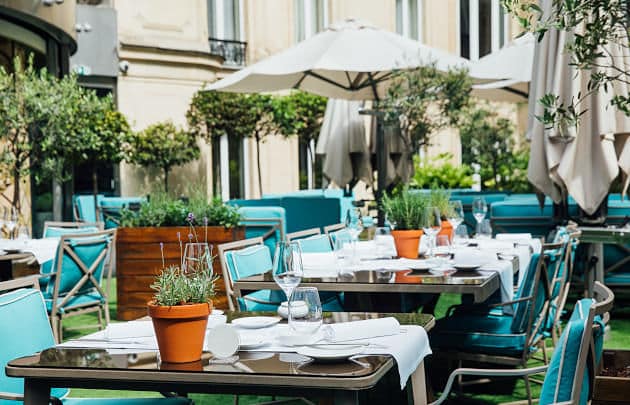
These are all traditionally drinking establishments, but like pubs in the UK, they have increasingly turned to serve sandwiches and light (and in some cases even substantial) meals, notably at midday. In the past, breweries were supposed to serve only quality beer and sauerkraut – which is still the case – but nowadays you can get excellent and varied meals. Several Parisian brasseries are very famous.
Fast food
They have invaded France at a pace (though nothing like the pace of some other countries). McDonald’s is all over the place.
The local French (which is actually Belgian) chain of hamburger and fast-food outlets is called Quick.
There are plenty of other independent fast-food outlets, sometimes with weird pseudo-English names such as “Big-Ban”, “Royal Fast Food” “Mister Good Fast” or “Le Fast Fast” (fast food for those on a diet?)
Pizzerias
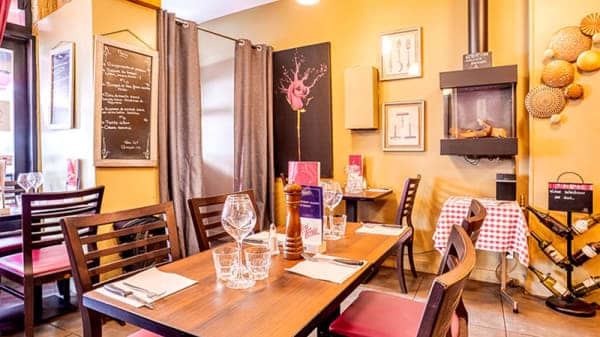
They can be found in virtually all French towns, and also along main roads. They tend to be independent establishments, rather than chains, but not always.
The French prefer traditional Italian-style pizzas, on a thin crust, and it is not common to find deep-pan pizzas. Good pizza restaurants operate on the same model as traditional French restaurants, offering three-course meals, where the main course is a pizza. It is very unusual to find pizzerias offering different size pizzas.
Creperies
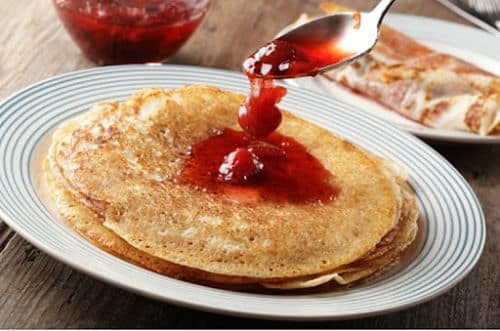
Creperies are restaurants specializing in the manufacture and sale of pancakes (composed of a more or less thin layer of dough, made from flour and eggs agglomerated to a liquid) or pancakes (a type of savory pancake made from buckwheat flour). They are made in front of you in a few minutes, to order. The galette is the “main course” and is the starter dish. On top are spread (at your choice) cold meats, eggs, etc. As for the pancake, it is rather the “dessert” with sugar, jam, and other pastry creams. A meal includes a pancake and a crepe. They are generally excellent. Pancakes originate from Brittany which produces cider. Hence a visit to the creperie is usually accompanied by a bottle of cider (usually 6% of alcohol). Very affordable price enchants the children.
Italian restaurants: many pizzerias double up as Italian pasta restaurants.
Chinese restaurants in France.
Chinese restaurants are now common in French towns – though often they are actually Vietnamese restaurants.
The food is of course oriental, but do not expect to find just the same choice on the menu as in an English or American Chinese restaurant.
Chinese restaurants are catering mainly to French customers, and this is reflected in the menu, particularly in the special three-course lunch or dinner menus. Chinese restaurants often offer good value for money, particularly with their set menus at lunchtime. However, they quite often have problems with the administration that verifies compliance with French hygiene rules.
Japanese restaurants. There are few Japanese restaurants in France and most of them are run by Asians from China or Vietnam – very few are really Japanese.
Indian restaurants
These restaurants are not as common in France as in the UK. As with Chinese restaurants, French Indian restaurants reflect French standards and habits, often paying considerable attention to presentation.
Algerian Moroccan and Tunisian restaurants. They are quite common, on account of the past links between France and North Africa. While many are quite basic restaurants, catering for France’s North African community, others, more up-market, are sophisticated and offer a fine eating-out experience. In particular, they offer different kinds of “Couscous” or “Tajine”. These are dishes for a complete meal (with dessert in addition)
Food from other nations: in big towns and cities, many other types of ethnic food restaurants can be found, but elsewhere, apart from pizzerias and the occasional oriental restaurants, the eating is mostly “à la française”.
Vegetarian food restaurants
France is a major producer of fruit and vegetables, but not a good place for vegetarian eating. On account of the generally good quality of food and catering, and the use of fresh products in French cuisine, vegetarianism never really took off in France. Nevertheless, there are now vegetarian restaurants in many French towns (if you can find them).
Choice of your restaurant and reservation
How to choose a restaurant
All restaurants must display in front of or against their storefronts, their menus and price cards, as well as a sampling of the prices of the beverages they offer. Also on the internet: many restaurants present the daily menu or a “typical” menu or card. You can therefore choose in advance before entering, which would please you.
Please note that the displayed prices include the service fixed administratively at 15%. So no service has to be added unless you want to reward the zeal of the waiters by leaving a few euros in addition to the bill (5 to 10%) (See our list of restaurants – link still to come).
Reservation of Paris restaurants (See section of the site “Reservation” – “Restaurant”)
If you have not made a reservation (it is often not necessary at lunchtime) you must ask the Maître d’Hôtel at the entrance of the restaurant for their availability.
A “standard” lunch reservation is usually not necessary. For a lunch in a high-end restaurant, the reservation can be more secure.
For a dinner and if you have chosen the restaurant in advance, it is safer to make a reservation, especially for gourmet restaurants. And for reputable and/or trendy restaurants, it may be necessary to reserve days or even more than a week in advance.
Words and terms you’ll come across with French meals and restaurants
(The pronunciation is indicated between square brackets)
Breakfast – le petit déjeuner [ler peutee day-zheu-nay].
Lunch – le déjeuner [ler day-zheu-nay]
Dinner – le diner [ler dee-nay].
A starter – une entrée [une on-tray]
The main course, le plat principal, [ler plar pran-see-parle]
A dessert, le dessert [ler dess-air]
Coffee: un café [ern caffay] (By default, this is espresso, a small strong black coffee, but not so strong as the real Italian one)
Coffee with milk: un café au lait [ern caffay olay]
Big cup of white coffee, (a latte) : un grand crème [ern gron krem ]
A jug of water: une carafe d’eau [une caraffe dough]
A glass of water: un verre d’eau [ern vair dough]
A jug of red/white wine: une carafe de vin (rouge / blanc) [une caraffe deu van (rooje / blon)]
A bottle of wine: une bouteille de vin [une butai-ille deu van]
I’ll take this menu: Je prendrai ce menu-ci. [jeu prondray seu menu-see]
Could you bring the bill please. L’addition, s’il vous plaît [la-dee-sio seel voo play]
Where are the toilets (washroom, etc): Où sont les toilettes, s.v.p? [oo son lay twa-let, seel voo play]
